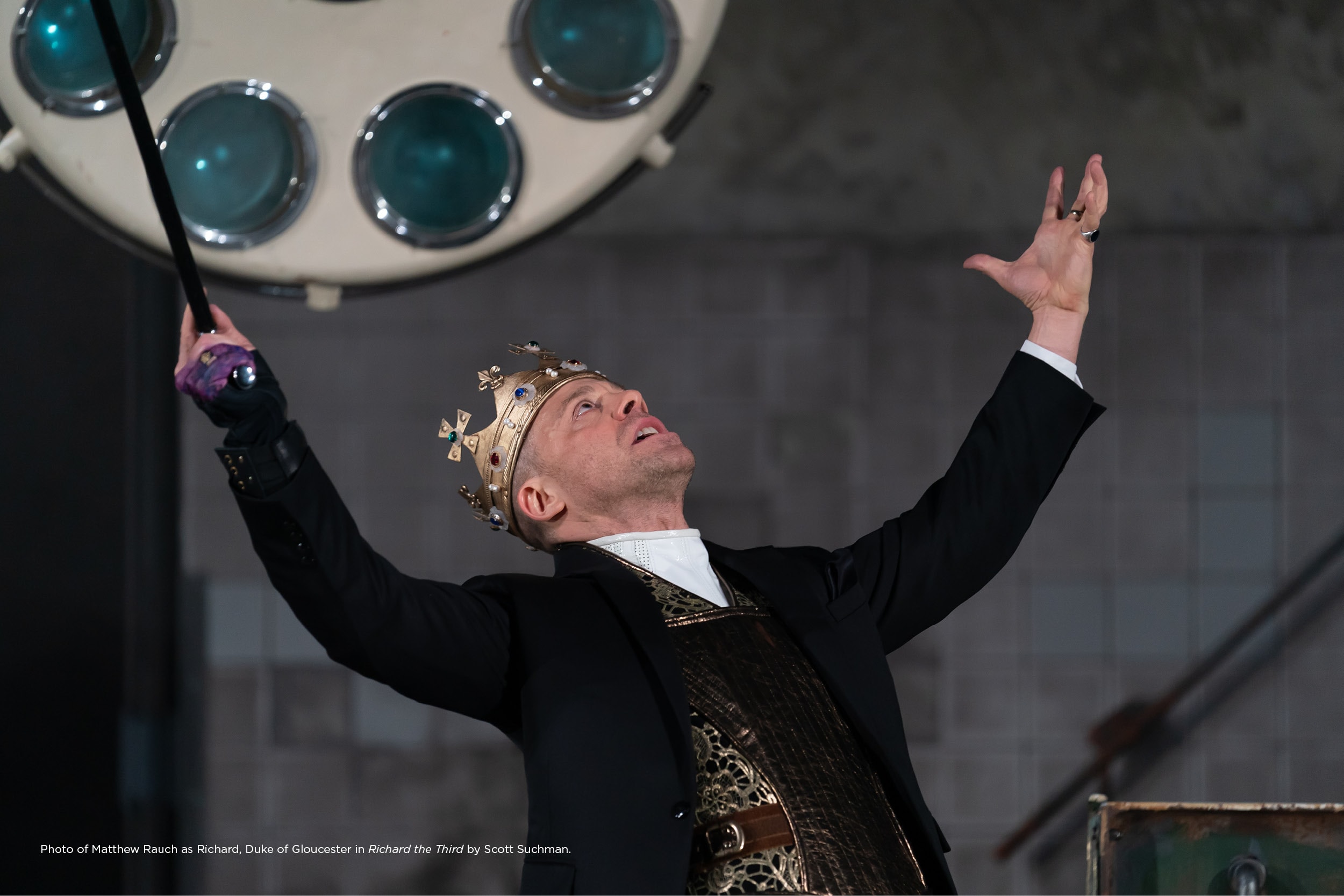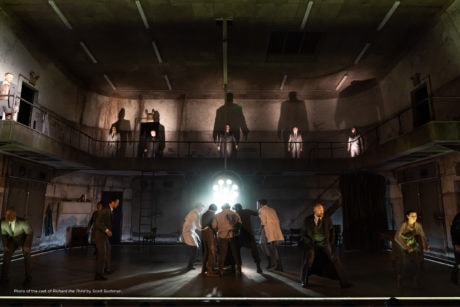Did ever a villain so enjoy his murderously evil ways as Shakespeare’s Richard III? In the Shakespeare Theatre’s production, Matthew Rauch’s Richard teaches a master class in duplicity and manipulation, all the while unable to contain his delight in machinations that would make Machiavelli blush. This is a Richard sans hump; he wears a leg brace, walks with a limp, and uses a cane. His deformities, perhaps, are more emotional than physical.

What makes his game so effective is the willingness of his enablers, including the ambitious Duke of Buckingham (Christopher Michael McFarland), the too naïve and easygoing Lord Hastings (Derrick Lee Weeden), or the readily cowed Mayor of London (Sofiya Cheyenne), to play along. Richard’s tyrannical rise and rule are made possible, by the consent, in a twisted way – or at least the complicity – of the governed.
The women in the play – Margaret of Anjou (Lizan Mitchell), Queen Elizabeth (Robynn Rodriguez), and Richard’s mother the Duchess of York (Sandra Shipley) – aren’t buying. As 15th-century women, they have little direct power, but their marginal position at least enables them to see, more clearly than the men, the monster in their midst: Margaret colorfully curses him, the Duchess wishes she had never borne him, and Elizabeth ultimately deceives him. Even Lady Anne (Cara Ricketts) – who in the historically most risible and dramatically least credible moment in the play, allows herself to be wooed by Richard hard upon the death of her husband, another of Richard’s victims – at last sees him for who he is, though too late to save herself.
While counted as one of Shakespeare’s historical plays, Richard III is by no means a work of history, conflating fact with legend and rumor and collapsing chronology and events into a narrative supporting the legitimacy of the Tudor dynasty in power at the time the play was written. Even Richard’s guilt in one of the more notorious crimes attributed to him in the play – the killing of the “young princes” in the Tower of London – has been challenged, most famously in a classic novel by British detective story writer Josephine Tey, “The Daughter of Time” (concerning which the Shakespeare Theatre is having a book talk next week).
The strong hand of Director David Muse is evident throughout the production. He made what he calls a “radical cut” of the show, some of the deleted exposition being displayed in projections identifying characters and events. Richard’s murders, often offstage in the script, become inventive theatrical set pieces, leaving ensemble members to mop up the blood. No two victims are killed the same way; the murder of Clarence, Richard’s brother, is particularly graphic. One value of this approach is that it shows Richard’s penchant for having others commit crimes he orders: he does not do his own wet work.
The production features a large ensemble, which frequently accompanies the action by rhythmically stamping their feet (or, towards the end, their bamboo poles), sometimes while sharpening knives to the beat (directed by movement director Steph Paul). Loud, heavy, ominous rock music by sound designer Lindsay Jones sets the tone of the proceedings. By contrast, Lap Chi Chu’s lighting design is full of subtle shadings, though in an intentionally narrow color palate. There is a lovely brief light cue at the end of the first act when Richard, on the balcony, is left in light for a few seconds after the main level of the stage blacks out following a murder.

Scenic designer Debra Booth’s set is a character in its own right: a massive gray, gloomy, harshly fluorescent-lit decaying industrial/brutalist concrete structure, with a balcony running around all three sides. Given Richard’s body count, it is helpfully fitted with morgue drawers. Murell Horton’s costumes tend toward contemporary, modern dress, leather and cloth rather than plastic, as Muse comments in his program note. The physical production aims at underlining the contemporary resonance of the play: “This should be an impossible play to experience without thinking about right now,” Muse asserts. Without naming names, Muse lists a series of characteristics he sees in Richard that remind him of “real people in our world who we wouldn’t believe if we saw them onstage.”
The degree to which the striking production concept goes to emphasize the present-day relevance of the play draws focus, to an extent, from the wellsprings of characters’ actions. The theater’s always-informative “Asides” booklet discusses in some detail factors that create the Richard we see; these motivations are more apparent on the printed page than in the production itself, which justifiably focuses on evil-in-action by its protagonist.
At the heart of it all remains one of the great villains, and most vivid characters, not only in Shakespeare but in dramatic literature generally. Rauch’s Richard is a memorable one, a reminder not of the banality but of the charisma of evil.
Running Time: Two hours and 40 minutes, including one intermission.
Richard the Third plays through March 10, 2019, at the Shakespeare Theatre Company’s Sidney Harman Hall, 610 F Street, NW, Washington DC. For tickets, call the box office at 202-547-1122 or go online.
Cody Nickell, George, Duke of Clarence/Tyrrell; Todd Scofield, Earl of Rivers; Jonathan Feuer, Lord Gray; Michael Rudko, Lord Stanley; Harry A. Winter, Archbishop of Canterbury; John Keabler, Sir William Catesby; David Bishins, King Edward IV/Ratcliffe; Ahmad Kamal, Brakenbury; Charlie Niccolini, Young Prince Edward; Logan Matthew Baker, Young Duke of York; Evelyn Spahr, Earl of Richmond; Sam Midwood, Lord Lovel




